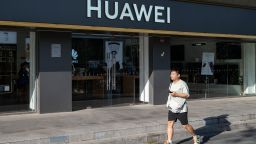Huawei, the tech giant which has been a flashpoint in the escalating rivalry between Washington and Beijing, says it is “back on track” with a strong 2023.
The Shenzhen-based conglomerate said Friday it expects to bring in more than 700 billion yuan ($99 billion) in revenue in 2023, partly off a stronger than expected performance in its electronics business. That is a 9% jump from the 642.3 billion yuan ($92.4 billion) recorded in 2022.
It is, however, still below the approximate $123 billion Huawei logged in 2019.
“After years of hard work, we’ve managed to weather the storm. And now we’re pretty much back on track,” Huawei’s rotating chairman, Ken Hu, said in a year-end message to employees.
The strong performance comes after the launch of Huawei’s Mate 60 Pro smartphone in August, which had shocked industry experts who didn’t understand how the company would have the technology to make such an advanced device following sweeping efforts by the United States to restrict China’s access to foreign chips.
The smartphone has been eagerly embraced by consumers, and has allowed Huawei to snatch market share away from Apple (AAPL) in China, according to Counterpoint Research.
Huawei ranked fifth in the Chinese market as of the end of September, growing its share from 10% in the first quarter to 14% in the third quarter. Apple, meanwhile, saw its slice of the pie shrink from 20% to 15% in the same period.
Results from Huawei’s device business “surpassed expectations,” Hu said in his memo, without providing details.
The Chinese company was once the world’s second biggest seller of smartphones, but lost its position after crippling US sanctions in recent years that impeded its ability to obtain critical components for its devices.
US policymakers have long claimed that Huawei poses a national security risk, alleging that the Chinese government could use the company’s equipment to spy. The company has repeatedly denied those allegations, and tried to improve its standing in Washington.
This year, however, Huawei has started to find its way back.
In March, the company said it was “out of crisis mode,” and reported progress on finding replacements for the components it had been cut off from by US sanctions.
The company is expected to continue its success in the new year, assuming it can expand the production of handsets powered by Kirin chips, Counterpoint analysts said in a November report, referring to the processors identified inside the Mate 60 Pro.
On Tuesday, the company launched new smartphones under Nova, its mid-range lineup, which are expected to gain popularity because of their relative affordability, according to analysts.
The sunny outlook stands in contrast to remarks made just last year by a Huawei executive, who’d said the company’s “fight to survive is not over yet.”
“Hard work has enabled us to survive and grow, but we still have serious challenges ahead of us,” Hu wrote in his memo Friday.
He warned that “geopolitical and economic uncertainties abound, while technology restrictions and trade barriers continue to have an impact on the world.”











